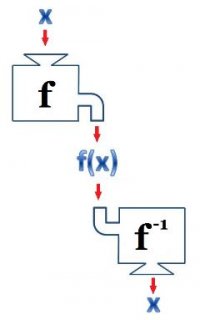actresschanel
New member
- Joined
- Jul 13, 2021
- Messages
- 9
I can find P^-1 (x) but how am I supposed to find P^-1(P(x))?
Thanks.
Thanks.
P^(-1)[P(x) ] = xI can find P^-1 (x) but how am I supposed to find P^-1(P(x))?
Thanks.
It would greatly help were you to show us how P(x) is defined.I can find P^-1 (x) but how am I supposed to find P^-1(P(x))?
Thanks.
Thanks!! Can you explain how that is so?P^(-1)[P(x) ] = x
It would greatly help were you to show us how P(x) is defined.
First find P^(-1)(x)P(x) = -12x^2+40x+200
Have you seen the machine models, for a function and its inverse?… how am I supposed to find P^-1(P(x))

Absolutely we can show you how that is so is if you tell us what P(x) is and what you got got P-1(x).Thanks!! Can you explain how that is so?
Ah, I didn't realize that you were talking about a defined function. My first reply was a general answer.P(x) = -12x^2+40x+200
And a perfectly good one. But I am not sure that giving that definitional statement will clarify things for this students as well as working it out in detail.Ah, I didn't realize that you were talking about a defined function. My first reply was a general answer.
?
Excellent. Thank you. So what did you get for the inverse? And was a domain specified?P(x) = -12x^2+40x+200
If you have [math]P^{-1}(x)[/math] then sub in P(x) for x to get [math]P^{-1}(P(x))[/math].I can find P^-1 (x) but how am I supposed to find P^-1(P(x))?
Thanks.
If you are asking about the inverse of [MATH]P(x)=-12x^2+40x+200[/MATH], it does not exits.P(x) = -12x^2+40x+200
I can find P^-1 (x) but how am I supposed to find P^-1(P(x))?
Thanks.
But the above is true only if [math]f:A\to B[/math] is a bijection( one-to-one, onto). Otherwise you must adjust the domain and other adjustments as needed.If a function [imath]f:A \rightarrow B[/imath] is invertible, means that [imath]f^{-1}: B \rightarrow A[/imath] exist and it's a function. Consider [imath]a\epsilon A[/imath] and [imath]b\epsilon B[/imath], then [imath]f(a)=b \Leftrightarrow f^{-1}(b)=a[/imath]. Now let's make the composition of the two functions: [math]f(f^{-1}(b))=f(a)=b[/math] Then, if [imath]P^{-1}[/imath] is the inverse function of [imath]P[/imath] [math]P(P^{-1}(x))=x[/math]
But the above is true only if [math]f:A\to B[/math] is a bijection( one-to-one, onto). Otherwise you must adjust the domain and other adjustments as needed.
